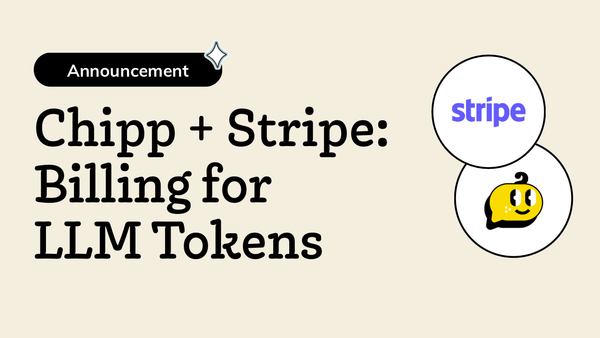Concerns about an AI bubble are overblown.
The real risk isn't financial excess. It's regulatory and cultural barriers blocking the AI buildout.
The benefits are clear: better healthcare, better customer service, better products, safer streets. AI will transform how we live and work. Talk of a bubble shouldn't slow us down.
The question isn't whether we're investing too much in AI. It's whether we're ready to let fear stop us from building the future.
Let's dive in to the concern over an AI bubble and then the reasons those concerns are misplaced, and potentially damaging. Ultimately, I think it's clear there isn't a bubble, and even if there is, that's an overall net positive for the United States.
Bubble Boy: The Case for an AI Bubble
The concerns of an AI bubble are not unfounded. Many of the current investment numbers are eye-popping to say the least.
American tech companies will spend $300 billion to $400 billion on AI this year. That's more than any group of companies has ever spent on anything. And they're not earning $400 billion back. Not yet.
Paul Kedrosky at MIT's Center for the Digital Economy ran the numbers. Data center spending accounted for roughly half of U.S. GDP growth in the first half of 2024. Half.
Here's how the spending breaks down: 60% goes to chips—mostly NVIDIA GPUs. The rest covers cooling, energy infrastructure, and construction. The recipients are narrow: a handful of chip manufacturers and a few geographies like Northern Virginia. So while this is helping the economy, the benefits are not widespread.
The scale of investment is unprecedented. It rivals the telecom bubble of the late 1990s. In terms of concentration and speed, we're in uncharted territory.
The stakes are high. Roughly half of last quarter's GDP growth came from AI infrastructure. More than half of stock market gains in recent years came from AI-related companies. If this buildout falters, there are fears that the cascade would hit technology, the economy, and politics.
So are the signs there for a bubble? Unprecedented capital is chasing returns that haven't materialized yet.
Surprisingly, I say no.
Party Like It's 1949
The right historical parallel isn't 1999. It's 1949.
After World War II, America faced a housing crisis. Veterans needed homes. The baby boom intensified demand. Homeownership jumped from 44% in 1940 to over 61% by 1960. Private housing starts rose twentyfold, hitting 1.7 million by 1950.
Lumber prices spiked. Cement prices surged. Critics worried about affordability.
The demand forced innovation.
Levitt & Sons revolutionized housing. They applied assembly-line principles to homebuilding. Specialized teams moved from house to house, performing specific tasks in 27 steps. At peak efficiency: one home every 16 minutes. Thirty-six homes per day.
The result? Homes for $7,000 with no money down. That's $92,000 in today's dollars—$1,500 cheaper than competitors while making $1,000 in profit per house. The Levitts bought timberland and built their own mill, saving 40% on lumber. By the mid-1950s, builders like Levitt could deliver a home for 20–30% less cost per square foot than a traditional contractor.
Despite temporary price spikes, innovation and scale drove real costs down. Quality improved. Standards of living rose.
The AI parallel is striking.
AI demand is driving energy costs up short-term. But it's forcing the innovation we need. Nuclear plants coming back online. New nuclear facilities planned. Solar and wind adoption accelerating past forecasts. AI infrastructure is decarbonizing the economy faster than any policy mandate ever could.
The 1949 housing boom left America with better, more affordable housing and manufacturing capabilities that boosted the entire economy. The AI buildout will leave us with a modernized, cleaner, more robust energy grid. Infrastructure that benefits everyone for decades.
This Is Not 1999
The dot-com comparison is wrong.
The AI demand is real and growing. This is not a case of potential demand for online dog food. Instead, we have a shortage now.
As the founder of an AI company that has tried to buy chips and watched users on AI, it is clear that there is already a lack of capacity. As models become more powerful and applications get better at helping users onboard to AI, the demand will only increase.
The improvement in models will get more efficient but paradoxically require more tokens, basically data used by AI. Already this week we saw the explosion of the time the new Claude 4.5 model can run. It can now code autonomously for over 30+ hours creating an application like Slack on its own:
Claude Sonnet 4.5 can autonomously create a chat app akin to Slack or Teams by producing 11,000 lines of code over 30 hours. pic.twitter.com/FRN7jNGYGQ
— prinz (@deredleritt3r) September 29, 2025
Now, imagine AI agents like this running continuously in the background to do everything from analyzing CCTV video footage to calculating economic activity to watching weather data. It's clear that AI will just "be on" like electricity. A true Jevons Paradox indeed.
As someone with a front seat at Cisco to the dot com crash, Anand Iyer summarizes it well:
Then (1999):
- Users weren't ready. Dial-up. No mobile. Immature e-commerce.
- Capital vanished overnight. IPO window closed. VC dried up.
- Metrics were fake. No standard CAC/LTV. Cash burn with no conversion.
- Infrastructure overbuilt for demand that never showed.
- Business models broken. Scale first, hope revenue follows.
Now (2025):
- Users are demanding more capacity.
- Tech companies scramble to keep up with workloads.
- Jensen Huang at NVIDIA notes: "Every hyperscaler has realized they dramatically underbuilt. Every forecast we've seen has been too low. We're not building for speculation. We're building for active workloads."
“This feels like 1999 again.”
— anand iyer (@ai) September 26, 2025
No, it doesn’t. And I was there (here).
I joined Cisco in January 2000 as a co-op, then full-time in May 2001. At the time, Cisco was the hottest infra company on the planet, riding the wave of the dot-com boom.
But by the time I started… https://t.co/xzGBQNWwlJ
We are not in a hype cycle. We are in a compute bottleneck.
The Evidence: AI Already Works
Sometimes the talk of a bubble refers not to the economics of AI but the performance of AI.
Users feel let down that AI isn't as amazing as it should be, makes too many mistakes, hallucinates, or doesn't change their life immediately...even though if you would have told your former self you could write an essay in seconds your mind would have been blown.
Fears of an AI letdown are unfounded.
Recently OpenAI launched new benchmarks that don't just test models against arbitrary tests but instead head to head against humans. In these benchmarks, a human performs a task and an AI performs the same task. The results are shown to a judge in a blind trial—they basically compare the two and pick their favorite without knowing which one is human. AI already is equal or better than humans in almost 50% of tasks. Plus, the AI is 100x faster and 100x cheaper.
great new eval from openai: GDPval
— vittorio (@IterIntellectus) September 25, 2025
they tested AI models on real occupations across the economy (lawyers, nurses, engineers, analysts) on 1,300 tasks from actual deliverables like briefs, blueprints, care plans
models are being benchmarked directly against industry experts, not… https://t.co/LJ51N8YHYy pic.twitter.com/dEADGMQVfy
The impact is showing up in life-or-death applications. In radiology, AI systems now detect prostate cancer on MRI with superior performance compared to radiologists (AUROC: 0.91 vs. 0.86), catching 6.8% more significant cancers (Frontiers Research, 2024).
In transportation, Waymo's autonomous vehicles powered by AI showed an 88% reduction in property damage claims and 92% reduction in bodily injury claims compared to human drivers over 25.3 million miles (Swiss Re Study, December 2024).
After 25.3 million autonomous miles driven, @Waymo vehicles have an 88% reduction in property damage claims and a 92% reduction in bodily injury claims compared to human drivers per mile driven. 🚖 https://t.co/LarEln7n0l pic.twitter.com/7ebvsuI7Tw
— Jeff Dean (@JeffDean) December 20, 2024
It's clear to me that we are already at the point that it's morally wrong to NOT transition to self-driving transportation as quickly as possible. Data from just two weeks ago drives this home:
I don't know how people can look at Waymo's safety data (or just ride in one) and not feel like we live in an age of miracles. The car! Drives! Itself! pic.twitter.com/mzX11DsYDe
— Kevin Roose (@kevinroose) September 16, 2025
More exciting is that AI is able to do things humans are not. AI now enables us to edit DNA at scale.
This repositions human genomes as software with AI the developer to solve diseases. Scientists edited 1 million bases of human DNA in a single shot—a magnitude leap beyond CRISPR's few-letter edits. The first real case of treating the human genome as software.
this is insane
— vittorio (@IterIntellectus) September 25, 2025
scientists just edited 1 million bases of human DNA in a single shot
the more known CRISPR can only edit a few letters at a time, but this is the first real case of human genome as software
1/ https://t.co/q35aZ2MpE3 pic.twitter.com/xtuxi7Gksd
Drug discovery is accelerating. Diagnostic accuracy improving. Personalized medicine expanding. Healthcare access broadening. Costs dropping through automation.
Beyond the science fiction, AI is now translating in real time providing custom support, healthcare assistance and more to anyone regardless of language. In education, the World Bank showed providing AI tutors to students in Nigeria helped the students learn in six weeks what would normally take two years.
And this is today. The hype of AI may have raised expectations but the impact is already here.
Why a "Bubble" Would Actually Help Us
Even if you don't buy that there is enough demand to justify the investment or don't buy the impact of AI—does it matter if there is an AI bubble?
Byrne Hobart and Tobias Huber, authors of Boom: Bubbles and the End of Stagnation, would argue no. In their excellent book they note how bubbles are key drivers of progress. As they write,
bubbles are uniquely suited to incubate and accelerate future technologies that can break through stagnation and accelerate growth
Bubbles focus talent, attention and resources on a specific goal. From the Manhattan Project to the Apollo program to the internet, they map the positive impact bubbles have had throughout the past century. Financial bubbles, while often maligned as destructive forces, have in fact been the engine of past breakthroughs and will drive future advances.
The dot-com bubble overbuilt fiber optic cables. Short-term financial pain. Long-term, it created the foundation for Web 2.0 and mobile. The railroad bubble of the 1840s overbuilt track. It enabled economic growth for decades.
Larry Page, co-founder of Google, has purportedly been saying:
I am willing to go bankrupt rather than lose this [AI] race
That sounds like bubble talk if I've ever heard it! But...that's ok!
Let Google spend its money while we benefit. If they take the risk and succeed, they can get their just rewards.
The consistent pattern: bubbles leave valuable infrastructure behind. And with AI, we're already seeing what that infrastructure looks like.
The Infrastructure We're Building
Compute infrastructure. Data centers. Chips. Training datasets. Benchmarks. Open source tools. Talent pipelines. Research institutions.
This foundational infrastructure creates capacity for unknown future applications. It lowers barriers for innovators and enables experimentation. It builds competitive advantage versus other nations. It ensures sufficient capacity when breakthrough moments arrive.
It's almost a given that some will over invest. Some will lose their bets. But, many of those investments, especially beyond the GPUs, will remain. It's productive excess.
The Energy Grid We're Upgrading
Perhaps the most important infrastructure benefit is one that surprises most people: AI is financing a complete modernization of America's energy grid.
OpenAI alone increased its capacity ninefold in 2024. They plan to scale 125x further by 2033. That exceeds India's current energy capacity. One company.
OpenAI have 9x'd their capacity this year, and have a goal to 125x further by 2033, thus exceeding current energy capacity of the whole of India - as per @alexeheath reporting of @sama's internal slack note.
— Peter Gostev (@petergostev) September 26, 2025
One thing to note is that 125x energy capacity increase understates the… pic.twitter.com/7i0EXZDRcF
Here's the paradox: AI demand is accelerating decarbonization.
Nuclear plants scheduled for retirement are coming back online. Three Mile Island's Unit 1 reactor is being restarted to power Microsoft data centers with 835 megawatts—a 20-year deal. Palisades Nuclear Plant in Michigan, shuttered in 2022, is on track to return to operations in 2025.
New nuclear facilities are being planned and fast-tracked. Oracle secured permits for a gigawatt-scale data center powered by three small modular reactors (SMRs). Google partnered with Kairos Power to build up to seven SMRs providing 500 megawatts by 2030. Amazon plans to deploy 5 gigawatts of nuclear energy by 2039.
Solar and wind adoption is accelerating past forecasts. Nearly 2.6 GW of generation and storage capacity awaits grid connection, with over 95% for zero-carbon resources like solar, wind and battery storage. The technology sector now accounts for more than 68% of corporate renewable procurement deals. Google has signed supply agreements with more than 100 solar and wind projects globally, while Microsoft has contracted 5.7 gigawatts of renewable capacity.
What's the best estimate of future solar + wind adoption—in the next few decades? Existing ones are bad. Any valid long-term guesstimate? pic.twitter.com/gCSc05Ja3G
— Tomas Pueyo (@tomaspueyo) September 25, 2025
Energy forecasts have been too conservative. Solar and wind deployment repeatedly outpaces projections. The need to power AI is decarbonizing the economy faster than climate policy ever could evidenced by the fact that Texas is the leading renewable producer—generating 169,442 gigawatt-hours from wind and solar in 2024, nearly double California's output.
Profit is accomplishing what climate regulation struggled to achieve.
It feels like 1949 all over again. Short-term pressure on resources is forcing innovation and infrastructure investment that benefits everyone for decades. AI is financing a complete modernization of America's energy grid. An upgrade we needed regardless and an upgrade everyone will benefit from for generations to come.
The Real Threats: What Could Actually Stop AI
As Julian Schrittwieser writes, humans are just bad at understanding exponentials, and nothing is more exponential than the growth of AI.
A technology can be transformative and still exist within a bubble. There are numerous threats that could derail AI—timing mismatches between buildout and user adoption, more efficient competing alternatives, geopolitical supply chain disruptions, or financial engineering unraveling.
Technology working isn't enough. Infrastructure, finance, and politics must cooperate.
But the biggest threat is neither technical nor economic. It's political.
The Real Risk: NIMBYism 2.0
Today, we're at risk of blocking the energy infrastructure and data centers needed to usher in the age of AI.
I noticed this first while driving my daughter to school. The Top 40 station of all places (s/o Gabe and Angie!) had a brief news story of the massive $3 billion data center being built north of Fargo. The first thing they mentioned was a quote from the head of the power company assuring listeners that their utility bills would not being going up.
Then, I started seeing it everywhere.
Indianapolis residents shut down a $1 billion Google data center. It would have used 1 million gallons of water daily so the community organized to kill it.
Indianapolis residents have shut down a proposed Google data center.
— More Perfect Union (@MorePerfectUS) September 25, 2025
The tech giant wanted to build a massive 500 acre facility, but people got organized and stopped them.
The $1 billion data center would've used one million gallons of water a day. pic.twitter.com/gUytDTTQMX
The concerns are legitimate. Water usage, energy costs, environmental impact—these matter. Past infrastructure buildouts have left real scars. I think of the Rondo neighborhood in my former home of St. Paul, where 700 Black family homes were demolished between 1956 and 1968 for I-94 construction. Progress requires input and care for communities.
But there's a difference between thoughtful opposition that demands accountability and blanket rejection that blocks necessary infrastructure. Indianapolis could have negotiated water recycling systems, community benefits, or environmental safeguards. Instead, they walked away from $1 billion in investment and the jobs and tax revenue that come with it.
I fear the same could happen with our energy grid.
If we're too concerned about local environmental impacts, we'll continue causing wide-scale damage to the global environment. We'll be cutting off our nose to spite our face.
Public anxiety is high about AI generally. Whether it is fears of job loss or just fear of the unknown, people are primed to oppose the infrastructure needed for the next phase of our economy.
If we let NIMBYism win, we miss the infrastructure upgrade AI is willing to finance. We're left with an outdated grid, fossil fuel dependence, and a competitive disadvantage against nations that chose to build.
The 1949 lesson: embrace the demand surge, enable the buildout, reap the long-term gains.
The Choice: Build or Fall Behind
The real risk isn't a bubble. It's missing the revolution entirely.
Bubble concerns are overblown. Even if some companies fail, even if there's "overinvestment," the infrastructure remains. The decarbonized energy grid remains. The compute capacity remains. The trained workforce remains. These aren't losses—they're productive excess that future innovators will build on for decades. Why not let Big Tech rebuild our energy system?
The biggest threats aren't technical or financial. They're self-imposed: regulatory overreach, cultural resistance, and opposition that blocks globally beneficial infrastructure.
Other nations are watching. China isn't debating whether to build. They're building. We can embrace the AI buildout, demand accountability from developers, and capture the benefits. Or we can let fear slow us down while other nations sprint ahead.
The 1949 housing boom wasn't perfect. Rondo reminds us of that. But America chose to build, and the result was decades of prosperity and a transformed economy. The AI buildout offers the same choice.
This time, let's build with both urgency and care. Let's demand that data centers address community concerns—water recycling, local hiring, environmental safeguards, community benefits. But let's not mistake caution for wisdom or delay for due diligence.
The cost of moving too slowly far exceeds the cost of moving too fast.
The infrastructure that powers the next century is being built right now. The question is whether we'll be the ones building it.




